PEDAGOGIE / ENSEIGNEMENT DES LANGUES
> Lequartierfrancais
Duuno. TWO20TWO. Concevoir des objectifs d’apprentissage clairs. Accueil. [Newsletter 236] Les différents modèles d'apprentissage. L’approche pédagogique par objectif est le modèle le plus courant. « Être capable de… » suivi d’un verbe d’action est la règle quasi unique utilisée en conception pédagogique.
![[Newsletter 236] Les différents modèles d'apprentissage](http://cdn.pearltrees.com/s/pic/th/newsletter-apprentissage-222200444)
Ce modèle par objectif est celui du « conditionnement ».
NeuroLearning et formation, Neuro-Learning et managemenet, les neurosciences appliquées au domaine professionnel. (206) The Jigsaw Method. The Jigsaw Classroom.
Stratégies d'apprentissage
LexiqueMes neurones aiment le lexique #3 : quel lexique ?
Passif et actif ne sont pas uniquement des termes grammaticaux désignant l’importance de l’engagement ou pas du sujet dans l’action : on peut également catégoriser le lexique selon ce que l’on veut en faire : de la réception ou de la production ?
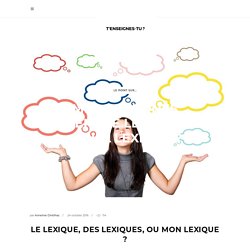
En résumé, faut-il apprendre tous les mots de la même manière ? Et comment opérer un choix ? QUEL lexique ? Dans la classe, force est de constater que la « liste » des éléments à mémoriser pour augmenter son lexique reste globalement la même pour tous les apprenants.
Typologie de kolb. (239) Deux activités d'apprentissage coopératif en classe de FLE. We help great education practice become common practice.
Veille pedagogique. Big Is Best? Smaller Class Size Doesn't Always Benefit Students, Study Finds. EAST LANSING, Mich. — It’s widely believed that smaller, more intimate, class sizes are better suited for student learning than larger classes.
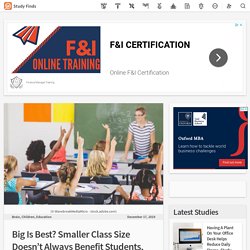
However, a new long-term study on math and science teaching trends finds that smaller class sizes don’t necessarily always lead to higher grades and achievements. Ultimately, the research team say, the effect of class size on student performance is dependent upon a number of additional factors such as country, the subject being taught, and various cognitive and non-cognitive skills. It’s easy to understand why most believe smaller classes are the way to go. Fewer students in each class facilitates more individualized attention from teachers, and makes it easier for administrators to maintain a sense of control. Due to these reasons, various countries have instituted limits on how large classes can be, with many capping the number at around 30 students per class.
The Teacher’s Role in Finland's Phenomenon-based Learning. “When you say that phenomenon-based learning has to be student-centered, teachers think I can’t do anything, I just have to step back and let the students do their thing,” Elo said.

He hasn’t found that to be true. Teachers have to make sure students know the foundational knowledge they need on a given topic to even consider developing a research question within it. They need to teach students how to craft appropriate research questions that can lead to interesting and engaging, and hopefully even original, research opportunities.
(206) The Jigsaw Method. Universal Design for Learning. Universal Design for Learning (UDL) is an educational framework based on research in the learning sciences, including cognitive neuroscience, that guides the development of flexible learning environments and learning spaces that can accommodate individual learning differences.[1] Universal Design for learning is a set of principles that allow teachers with a structure to develop instructions to meet the diverse needs of all learners.
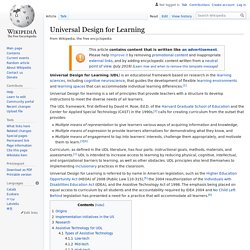
Recognizing that the way individuals learn can be unique, the UDL framework, first defined by David H. Rose, Ed.D. of the Harvard Graduate School of Education and the Center for Applied Special Technology (CAST) in the 1990s,[2] calls for creating curriculum from the outset that provides: Origins[edit] The concept and language of Universal Design for Learning was inspired by the universal design movement in architecture and product development, originally formulated by Ronald L.
(206) Ed-Talk: Learning with an Emotional Brain - Mary Helen Immordino-Yang. Thinking Together, University of Cambridge » Projects.
A typical outline for session s:
10 Fun Alternatives to Think-Pair-Share. All learners need time to process new ideas and information.
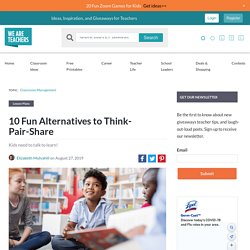
They especially need time to verbally make sense of and articulate their learning with a community of learners who are also engaged in the same experience and journey. In other words, kids need to talk!! Problem is, sometimes it’s hard to stay on subject without a little guidance. That’s why structured discussions really work best with children, regardless of their maturity level. These ten discussion techniques (and a little purposeful planning) go beyond the traditional turn and talk/think-pair-share to give students an opportunity to deepen their understanding while practicing their verbal skills.
Active Learning Strategies. Active Learning Strategies help to initiate learners and instructors into effective ways to help everyone engage in activities based on ideas about how people learn. Multiple active learning strategies may be used in each of the active learning designs.
(206) How to do a Turn and Talk - TeachLikeThis. Think-Pair-Share. Classroom Strategies Background Think-Pair-Share (TPS) is a collaborative learning strategy in which students work together to solve a problem or answer a question about an assigned reading.
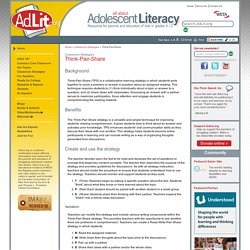
This technique requires students to (1) think individually about a topic or answer to a question; and (2) share ideas with classmates. Discussing an answer with a partner serves to maximize participation, focus attention and engage students in comprehending the reading material. Benefits. Les enseignements pratiques interdisciplinaires (EPI)
Apprendre dans les interstices - Thot Cursus. Liberté encadrée Un interstice est une chose minuscule, un entre deux, une faille.
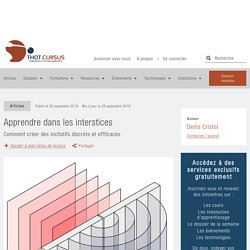
Flweblog - FLE et didactique des langues. Authentic assessment - Institute for Teaching and Learning Innovation - University of Queensland. Adams Becker, S, Brown, M, Dahlstrom, E, Davis, A, DePaul, K, Diaz, V & Pomerantz, J, (2018) NMC Horizon Report: 2018 Higher Education Edition.
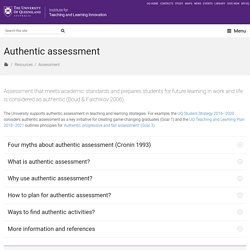
EDUCAUSE, Louisville, CO. Retrieved from. La capsule : un outil pertinent pour la progression spiralaire de la grammaire. Dans le cadre de la classe inversée, la capsule peut être un outil très utile pour revoir des notions de grammaire supposées acquises et à partir desquelles le nouveau cours devrait commencer, selon la progression spiralaire qui régit souvent les choix des points de langue : on aborde plusieurs points identiques au niveau A1, puis A2, puis B1 etc., en approfondissant chaque fois le point étudié, en s’acheminant vers plus de complexité.
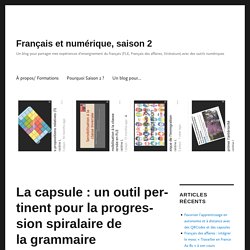
Or, souvent, ces prérequis ne sont pas acquis. Parfois les apprenants ne maîtrisent pas le même vocabulaire technique ou l’ont oublié, ce qui creusera l’écart entre ceux qui ont les pré-requis et les autres. Je me suis donc posé la question : une capsule peut-elle aider à estomper ces différences d’acquisition ? En cours, à partir d’une phrase, une étudiante a reconstitué le cours, a ajouté des exemples. WordPress:
CLASSE INVERSEE
Blog de M@rcelBlog de M@rcel. Écriture collaborative : varions les styles !
L’écriture collaborative apporte l’idée d’un document construit à plusieurs mains. Elle a été popularisée par plusieurs types d’outils qui permettent un partage du document au travers d’Internet. Pour écrire, modifier ou commenter un texte commun.
Jean-Michel Cornu. WEBINAIRE GRATUIT "Qu'est-ce le Neurolanguage Coaching?" (en Français) - ELC Language Coaching Certification.
WEBINAIRE GRATUIT “Qu’est-ce le Neurolanguage Coaching?” (en Français) November 7 7 novembre, 8pm-9pm Paris. 12 jeux hors du commun pour favoriser l'esprit d'équipe. « Encore un autre jeu stupide pour favoriser l'esprit d'équipe au sein de l'entreprise », déclare un employé insatisfait. Oups. Lorsque cette pensée traverse l'esprit de vos employés, vous pouvez considérer que votre stratégie pour renforcer l'esprit d'équipe n'est pas la bonne.
Les activités et les jeux favorisant l'esprit d'équipe sont censés être éducatifs tout en étant agréables. Ils permettent à l'équipe d'apprendre les uns des autres ; de découvrir comment les autres pensent, travaillent, résolvent les problèmes et s'amusent.
Suivre les compétences des élèves avec Podio. Par souci d’organisation professionnelle et pédagogique (mais aussi par un tropisme technophile personnel tenace…), j’explore diverses façons numériques de suivre les profils de compétences et les progressions des élèves. Je vous propose ici un cahier des charges pour le choix de l’outil numérique et un dispositif avec l’application Podio. Un cahier des charges. ILOTS COOPERATIFS. PEDAGOGIE COOPERATIVE. Îlots ludifiés.
Premiers pas avec Scratch 3.0. CE QU’ON PEUT FAIRE EN CLASSE INVERSEE. Empowering Students Through Connections-Based Learning – Edmodo. We’d like to thank Sean for this insightful analysis ahead of his session at EdmodoCon. If you’re interested in more from Sean, register for EdmodoCon today to see him speak live about connections-based learning. If you’d like to learn more about how students can practice healthy digital connections, check out this collection of digital citizenship resources.
We’re all looking for a way to frame learning in the 21st century. Personalization, a shrinking world, exabytes of information at students’ fingertips: each of these trends have led us to look at education in a new light.
Nouvelles idees tendances courants
FICHES ET GRILLES D'EVALUATIONS DIVERSES. Fiches pratiques pedagogiques tv5 monde. Neuropédagogie.

![[Newsletter 236] Les différents modèles d'apprentissage](http://cdn.pearltrees.com/s/pic/th/newsletter-apprentissage-222200444)








